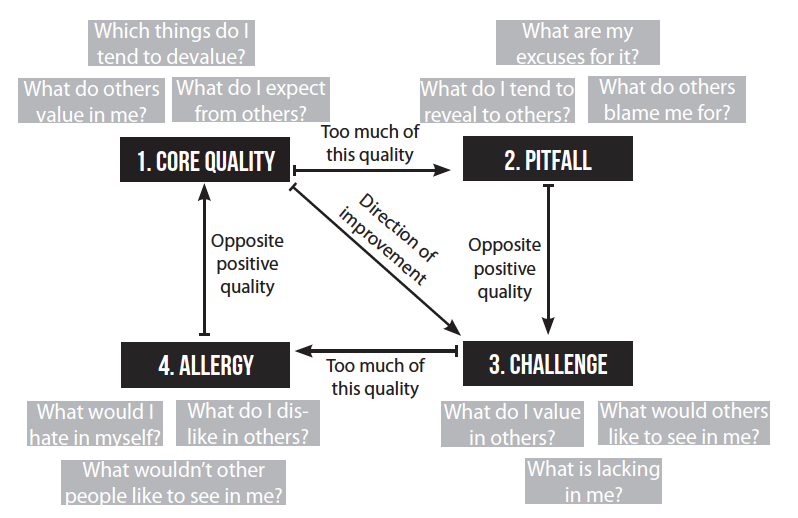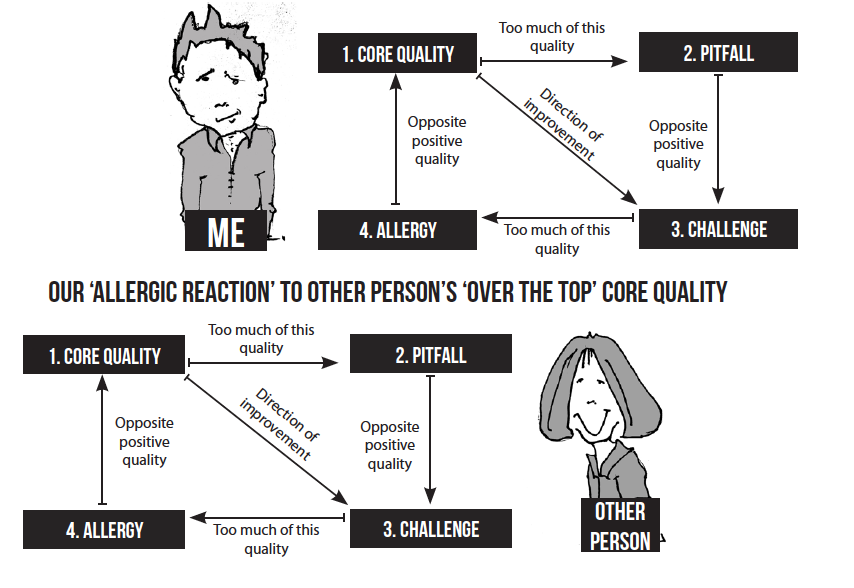Core Quality – a model for self analysis and personal development
As trainers, we are doing our best to create a space for our participants to learn not only about a particular topic but also to develop personally. Acknowledgement and improvement of personal qualities and certain attitudes is a very interesting and challenging process. As a trainer, I believe that I have to be able to “work on myself” if I’m asking participants to work on their personal/professional development.

Why did I choose this tool and how does this apply to being a trainer?
Better self-perception helps a trainer to make conscious and responsible choices to improve professionally and personally. Therefore, we suggest you to have a look at a very meaningful tool called the ‘Model of core qualities.’ It is designed to improve the knowledge of yourself and your relationship with others as well as to determine the directions of your improvement.
Main content:
A core quality is part of the personality, which takes a long period of time to form and constitute a considerable part of a person’s entity. It can be a certain set of abilities, behaviors and attitudes. A core quality is something that would make one person a different person, if it was taken away from him. The knowledge of your core qualities can help you use them better in and outside a work environment. According to this model, you can also determine:
· What the possible dangers are of having a certain quality (pitfall);
· A possible direction for improvement and what other qualities can be valuable to a person (challenge);
· What qualities or features a person hates in themself and in others (allergy).
The author of this model (https://corequality.nl/en/) D. Ofman (1992) emphasizes that a core quality is not a character feature, but rather a certain potential of a person, which can be used if applied consciously. That potential is always inside of a person and cannot be ‘turned on’ or ‘turned off’. The difference between qualities and competences is that a core quality comes from inside, while a competence is acquired from outside. A core quality can help us properly use competences we possess. We suggest the trainers to take a deeper look and use this tool for a better understanding of themselves and others.
Every core quality (a person can surely have more than one of them), also has three related qualities, which all together make a core quality square. Each related quality is very important since it gives guidelines for self-development.
1. Core quality
2. Pitfall
3. Challenge
4. Allergy

Questions provided next to each element can help to clearly determine each part of the square.
Pitfall. Each core quality can become a weakness if it is overdeveloped. In this case a person falls into a kind trap, where they can do harm to themself and to others. For instance, the pitfalls of over developing the core quality of rationality is being too cold and indifferent and ignoring emotions. Pitfalls can be recognized by remembering the things we are blamed for by others and what things we tend to justify in ourselves (e.g. “I will not give in to emotions – I have to stay calm, since staying rational is the most important thing”). Pitfalls are not contrary to core qualities, but rather a certain distortion of them. If the quality is rationality, then the trap will not be irrationality. A pitfall is often a quality that other people notice in us and reproach us for it. But by recognizing your trap, you can also find out your core quality. There are people who find it difficult to determine their strong sides, but they are quick to name certain weaknesses. This way the person can begin with their ‘pitfall’ and proceed to the following stage.
Challenge. Each core quality also has a related challenge. A challenge is a quality that is positively opposite to a pitfall. A challenge is also a quality which a person finds hard to apply. Following the previously provided example, if a person’s core quality is rationality, and the pitfall is coldness and indifference, then the challenge can be sensitivity and empathy. The quality of challenge supplements the core quality. By strengthening their own challenge, a person becomes more able to avoid their pitfall. The key to effectiveness is using a core quality together with the quality of challenge. So in our example it would be important for the person to maintain rationality, and to develop sensitivity and empathy.
Allergy. Each core quality also has a related allergy. An allergy is an excess of challenge. Each person has an allergy to their challenge, especially when this quality manifests itself in other people. For instance, if a certain person’s core quality is rationality and sensitivity is a challenge, then the allergy is manifested when sensitivity is expressed too strongly, e.g. oversensitivity, being overly emotional, etc. An allergy is a quality which a person cannot tolerate in themself or other people. The important thing is that an allergy is enhanced by those qualities that are very useful for a specific person, since an allergy is directly related to the challenge. The positive, opposite quality to an allergy is a person’s core quality.
The model of core qualities is a great tool for getting to know yourself better, but it is also useful in analyzing your relations with other people. When you’re facing an annoying person (i.e. a person who you are allergic to) you can recognize your challenge and strengthen your own core qualities. It is also important to understand that the quality in other people’s behaviour that makes us allergic is their trap. Therefore, in relation to another person, the squares of core qualities are the following:

It is often the case that a person gets into conflict with himself or others namely due to certain core qualities. The problem is that usually a person is allergic to the ‘over the top’ quality of their challenge (which should be the person’s pursuit). This kind of allergy manifests itself through intolerance to that person. We can look at this process from the perspective of other people’s reaction towards us. The other person starts to confront us when we display a quality, which they are allergic to. The more we react to this confrontation, the deeper we fall into our own pitfall. For instance, we have to work in a team with another trainer, who is a sensitive and empathic person. They can become annoyed by rationality and cold thinking, and the ensuing tension can make us act even more coldly and indifferently. So we fall into our trap just as the other person does, due to a stressful situation. This creates a vicious circle and provokes never-ending conflicts, and both people become allergic to each other, even though they both have highly valuable qualities. Perhaps in this case the oversensitive person should be more rational, and the rational one more sensitive.
The solution is looking for the pitfall into which you have fallen in relation to the other person. If you succeed in determining your own and other person’s pitfalls, which were provoked by going over the top with a core quality, then the relationship may change, because you may start valuing what the other has (their core quality) and learning from them.
Reflection questions:
- Which of your qualities you would name as core qualities, which define you as a trainer?
- Which qualities could be your pitfalls /allergies?
- Which qualities are your challenges, things you need to develop?
Exercises:
How to apply it in everyday life:
Play with this model and you will find many interesting aspects about your qualities and possibilities for development.




